Preeclampsia Correlates with an Increase in Cannabinoid Receptor 1 Levels Leading to Macromolecular Alterations in Chorionic Villi of Term Placenta
Abstract
1. Introduction
2. Results
2.1. Preeclampsia Increases CB1 Levels in the Chorionic Villi
2.2. Preeclampsia Does Not Change TRPV-1 Levels in Placenta
2.3. Infrared Spectra Analysis and Multivariate Analysis
2.4. Collagen Deposition in the Chorionic Villi Is Increased in Preeclamptic Placenta
2.5. Preeclampsia Does Not Change Lipid Composition but Triggers an Increase of Lipid Peroxidation
2.6. Preeclamptic Chorionic Villi Characterized by an Increase in Phosphoester Bonds
3. Discussion
4. Materials and Methods
4.1. Ethics Declarations and Sample Collection
4.2. Evaluation of Protein Levels by Western Blot
4.3. Immunohistochemistry and Image Analysis
4.4. Histochemical Analysis of Collagen and Lipid Content
4.5. FTIRI Analysis
4.6. Statistical Analysis
Supplementary Materials
Author Contributions
Funding
Institutional Review Board Statement
Informed Consent Statement
Data Availability Statement
Acknowledgments
Conflicts of Interest
References
- Ghulmiyyah, L.; Sibai, B. Maternal Mortality from Preeclampsia/Eclampsia. Semin. Perinatol. 2012, 36, 56–59. [Google Scholar] [CrossRef] [PubMed]
- Gestational Hypertension and Preeclampsia: ACOG Practice Bulletin, Number 222. Obstet. Gynecol. 2020, 135, e237–e260. [CrossRef] [PubMed]
- Preeclampsia: Clinical Features and Diagnosis—UpToDate. Available online: https://www.uptodate.com/contents/preeclampsia-clinical-features-and-diagnosis#H14938176 (accessed on 30 September 2022).
- Raymond, D.; Peterson, E. A Critical Review of Early-Onset and Late-Onset Preeclampsia. Obstet. Gynecol. Surv. 2011, 66, 497–506. [Google Scholar] [CrossRef] [PubMed]
- Rana, S.; Lemoine, E.; Granger, J.; Karumanchi, S.A. Preeclampsia: Pathophysiology, Challenges, and Perspectives. Circ. Res. 2019, 124, 1094–1112. [Google Scholar] [CrossRef] [PubMed]
- Turco, M.Y.; Moffett, A. Development of the Human Placenta. Development 2019, 146, dev163428. [Google Scholar] [CrossRef] [PubMed]
- Devisme, L.; Merlot, B.; Ego, A.; Houfflin-Debarge, V.; Deruelle, P.; Subtil, D. A Case–Control Study of Placental Lesions Associated with Pre-Eclampsia. Int. J. Gynecol. Obstet. 2013, 120, 165–168. [Google Scholar] [CrossRef]
- Kent, A.; Wa, B. Diagnosing Preeclampsia. Rev. Obstet. Gynecol. 2008, 1, 146. [Google Scholar] [PubMed]
- Maia, J.; Fonseca, B.M.; Teixeira, N.; Correia-Da-Silva, G. The Fundamental Role of the Endocannabinoid System in Endometrium and Placenta: Implications in Pathophysiological Aspects of Uterine and Pregnancy Disorders. Hum. Reprod. Update 2020, 26, 586–602. [Google Scholar] [CrossRef] [PubMed]
- Huang, S.M.; Bisogno, T.; Trevisani, M.; Al-Hayani, A.; De Petrocellis, L.; Fezza, F.; Tognetto, M.; Petros, T.J.; Krey, J.F.; Chu, C.J.; et al. An Endogenous Capsaicin-like Substance with High Potency at Recombinant and Native Vanilloid VR1 Receptors. Proc. Natl. Acad. Sci. USA 2002, 99, 8400–8405. [Google Scholar] [CrossRef] [PubMed]
- Sun, Y.; Alexander, S.P.H.; Garle, M.J.; Gibson, C.L.; Hewitt, K.; Murphy, S.P.; Kendall, D.A.; Bennett, A.J. Cannabinoid Activation of PPARα; a Novel Neuroprotective Mechanism. Br. J. Pharmacol. 2007, 152, 734. [Google Scholar] [CrossRef] [PubMed]
- O’Sullivan, S.E. An Update on PPAR Activation by Cannabinoids. Br. J. Pharmacol. 2016, 173, 1899. [Google Scholar] [CrossRef]
- O’Sullivan, S.E. Cannabinoids Go Nuclear: Evidence for Activation of Peroxisome Proliferator-Activated Receptors. Br. J. Pharmacol. 2007, 152, 576. [Google Scholar] [CrossRef] [PubMed]
- Ryberg, E.; Larsson, N.; Sjögren, S.; Hjorth, S.; Hermansson, N.O.; Leonova, J.; Elebring, T.; Nilsson, K.; Drmota, T.; Greasley, P.J. The Orphan Receptor GPR55 Is a Novel Cannabinoid Receptor. Br. J. Pharmacol. 2007, 152, 1092–1101. [Google Scholar] [CrossRef] [PubMed]
- Syed, S.K.; Bui, H.H.; Beavers, L.S.; Farb, T.B.; Ficorilli, J.; Chesterfield, A.K.; Kuo, M.S.; Bokvist, K.; Barrett, D.G.; Efanov, A.M. Regulation of GPR119 Receptor Activity with Endocannabinoid-like Lipids. Am. J. Physiol. Endocrinol. Metab. 2012, 303, E1469–E1478. [Google Scholar] [CrossRef] [PubMed]
- Habayeb, O.M.H.; Taylor, A.H.; Evans, M.D.; Cooke, M.S.; Taylor, D.J.; Bell, S.C.; Konje, J.C. Plasma Levels of the Endocannabinoid Anandamide in Women—A Potential Role in Pregnancy Maintenance and Labor? J. Clin. Endocrinol. Metab. 2004, 89, 5482–5487. [Google Scholar] [CrossRef] [PubMed]
- Park, B.; Gibbons, H.M.; Mitchell, M.D.; Glass, M. Identification of the CB1 Cannabinoid Receptor and Fatty Acid Amide Hydrolase (FAAH) in the Human Placenta. Placenta 2003, 24, 990–995. [Google Scholar] [CrossRef]
- Han, K.H.; Lim, S.; Ryu, J.; Lee, C.W.; Kim, Y.; Kang, J.H.; Kang, S.S.; Ahn, Y.K.; Park, C.S.; Kim, J.J. CB1 and CB2 Cannabinoid Receptors Differentially Regulate the Production of Reactive Oxygen Species by Macrophages. Cardiovasc. Res. 2009, 84, 378–386. [Google Scholar] [CrossRef] [PubMed]
- Mukhopadhyay, P.; Rajesh, M.; Bátkai, S.; Patel, V.; Kashiwaya, Y.; Liaudet, L.; Evgenov, O.V.; MacKie, K.; Haskó, G.; Pacher, P. CB1 Cannabinoid Receptors Promote Oxidative Stress and Cell Death in Murine Models of Doxorubicin-Induced Cardiomyopathy and in Human Cardiomyocytes. Cardiovasc. Res. 2010, 85, 773. [Google Scholar] [CrossRef] [PubMed]
- Comelli, F.; Bettoni, I.; Colombo, A.; Fumagalli, P.; Giagnoni, G.; Costa, B. Rimonabant, a Cannabinoid CB1 Receptor Antagonist, Attenuates Mechanical Allodynia and Counteracts Oxidative Stress and Nerve Growth Factor Deficit in Diabetic Mice. Eur. J. Pharmacol. 2010, 637, 62–69. [Google Scholar] [CrossRef] [PubMed]
- Fügedi, G.; Molnár, M.; Rigó, J.; Schönléber, J.; Kovalszky, I.; Molvarec, A. Increased Placental Expression of Cannabinoid Receptor 1 in Preeclampsia: An Observational Study. BMC Pregnancy Childbirth 2014, 14, 395. [Google Scholar] [CrossRef] [PubMed]
- Abán, C.; Leguizamón, G.F.; Cella, M.; Damiano, A.; Franchi, A.M.; Farina, M.G. Differential Expression of Endocannabinoid System in Normal and Preeclamptic Placentas: Effects on Nitric Oxide Synthesis. Placenta 2013, 34, 67–74. [Google Scholar] [CrossRef] [PubMed]
- Bienertova-Vasku, J.; Bienert, P.; Dostalova, Z.; Chovanec, J.; Vasku, A.; Vasku, V. A Common Variation in the Cannabinoid 1 Receptor (CNR1) Gene Is Associated with Pre-Eclampsia in the Central European Population. Eur. J. Obstet. Gynecol. Reprod. Biol. 2011, 155, 19–22. [Google Scholar] [CrossRef] [PubMed]
- Martínez, N.; Abán, C.E.; Leguizamón, G.F.; Damiano, A.E.; Farina, M.G. TPRV-1 Expression in Human Preeclamptic Placenta. Placenta 2016, 40, 25–28. [Google Scholar] [CrossRef] [PubMed]
- Robillard, P.Y.; Dekker, G.; Iacobelli, S.; Chaouat, G. An Essay of Reflection: Why Does Preeclampsia Exist in Humans, and Why Are There Such Huge Geographical Differences in Epidemiology? J. Reprod. Immunol. 2016, 114, 44–47. [Google Scholar] [CrossRef] [PubMed]
- Chau, K.; Welsh, M.; Makris, A.; Hennessy, A. Progress in Preeclampsia: The Contribution of Animal Models. J. Hum. Hypertens. 2021, 36, 705–710. [Google Scholar] [CrossRef] [PubMed]
- Pique-Regi, R.; Romero, R.; Tarca, A.L.; Sendler, E.D.; Xu, Y.; Garcia-Flores, V.; Leng, Y.; Luca, F.; Hassan, S.S.; Gomez-Lopez, N. Single Cell Transcriptional Signatures of the Human Placenta in Term and Preterm Parturition. eLife 2019, 8, e52004. [Google Scholar] [CrossRef] [PubMed]
- Accialini, P.; Abán, C.; Etcheverry, T.; Negri Malbrán, M.; Leguizamón, G.; Herlax, V.; Maté, S.; Farina, M. Anandamide Exerts a Differential Effect on Human Placenta before and after the Onset of Labor. Front. Physiol. 2021, 12, 667367. [Google Scholar] [CrossRef] [PubMed]
- Bonnier, F.; Byrne, H.J. Understanding the Molecular Information Contained in Principal Component Analysis of Vibrational Spectra of Biological Systems. Analyst 2011, 137, 322–332. [Google Scholar] [CrossRef]
- Notarstefano, V.; Sabbatini, S.; Conti, C.; Pisani, M.; Astolfi, P.; Pro, C.; Rubini, C.; Vaccari, L.; Giorgini, E. Investigation of Human Pancreatic Cancer Tissues by Fourier Transform Infrared Hyperspectral Imaging. J. Biophotonics 2020, 13, e201960071. [Google Scholar] [CrossRef] [PubMed]
- Notarstefano, V.; Belloni, A.; Sabbatini, S.; Pro, C.; Orilisi, G.; Monterubbianesi, R.; Tosco, V.; Byrne, H.J.; Vaccari, L.; Giorgini, E. Cytotoxic Effects of 5-Azacytidine on Primary Tumour Cells and Cancer Stem Cells from Oral Squamous Cell Carcinoma: An In Vitro FTIRM Analysis. Cells 2021, 10, 2127. [Google Scholar] [CrossRef] [PubMed]
- Talari, A.C.S.; Martinez, M.A.G.; Movasaghi, Z.; Rehman, S.; Rehman, I.U. Advances in Fourier Transform Infrared (FTIR) Spectroscopy of Biological Tissues. Appl. Spectrosc. Rev. 2016, 52, 456–506. [Google Scholar] [CrossRef]
- Stani, C.; Vaccari, L.; Mitri, E.; Birarda, G. FTIR Investigation of the Secondary Structure of Type I Collagen: New Insight into the Amide III Band. Spectrochim. Acta-Part A Mol. Biomol. Spectrosc. 2020, 229, 118006. [Google Scholar] [CrossRef] [PubMed]
- Licini, C.; Notarstefano, V.; Marchi, S.; Cerqueni, G.; Ciapetti, G.; Vitale-Brovarone, C.; Giorgini, E.; Mattioli-Belmonte, M. Altered Type I Collagen Networking in Osteoporotic Human Femoral Head Revealed by Histomorphometric and Fourier Transform Infrared Imaging Correlated Analyses. BioFactors 2022, 48, 1089–1110. [Google Scholar] [CrossRef] [PubMed]
- Belbachir, K.; Noreen, R.; Gouspillou, G.; Petibois, C. Collagen Types Analysis and Differentiation by FTIR Spectroscopy. Anal. Bioanal. Chem. 2009, 395, 829–837. [Google Scholar] [CrossRef] [PubMed]
- Belloni, A.; Furlani, M.; Greco, S.; Notarstefano, V.; Pro, C.; Randazzo, B.; Pellegrino, P.; Zannotti, A.; Delli, G.; Ciavattini, A.; et al. Uterine Leiomyoma as Useful Model to Unveil Morphometric and Macromolecular Collagen State and Impairment in Fibrotic Diseases: An Ex-Vivo Human Study. Biochim. Biophys. Acta Mol. Basis Dis. 2022, 1868, 166494. [Google Scholar] [CrossRef]
- Burton, G.J.; Sebire, N.J.; Myatt, L.; Tannetta, D.; Wang, Y.L.; Sadovsky, Y.; Staff, A.C.; Redman, C.W. Optimising Sample Collection for Placental Research. Placenta 2014, 35, 9–22. [Google Scholar] [CrossRef]
- Lyall, F.; Robson, S.C.; Bulmer, J.N. Spiral Artery Remodeling and Trophoblast Invasion in Preeclampsia and Fetal Growth Restriction: Relationship to Clinical Outcome. Hypertens 2013, 62, 1046–1054. [Google Scholar] [CrossRef]
- Xie, H.; Sun, X.; Piao, Y.; Jegga, A.G.; Handwerger, S.; Ko, M.S.H.; Dey, S.K. Silencing or Amplification of Endocannabinoid Signaling in Blastocysts via CB1 Compromises Trophoblast Cell Migration. J. Biol. Chem. 2012, 287, 32288–32297. [Google Scholar] [CrossRef]
- Štulc, J.; Štulcová, B.; Šmíd, M.; Šach, I. Parallel Mechanisms of Ca++ Transfer across the Perfused Human Placental Cotyledon. Am. J. Obstet. Gynecol. 1994, 170, 162–167. [Google Scholar] [CrossRef]
- Haché, S.; Takser, L.; Lebellego, F.; Weiler, H.; Leduc, L.; Forest, J.C.; Giguère, Y.; Masse, A.; Barbeau, B.; Lafond, J. Alteration of Calcium Homeostasis in Primary Preeclamptic Syncytiotrophoblasts: Effect on Calcium Exchange in Placenta. J. Cell. Mol. Med. 2011, 15, 654–667. [Google Scholar] [CrossRef]
- Seely, E.W.; Wood, R.J.; Brown, E.M.; Graves, S.W. Lower Serum Ionized Calcium and Abnormal Calciotropic Hormone Levels in Preeclampsia. J. Clin. Endocrinol. Metab. 1992, 74, 1436–1440. [Google Scholar] [CrossRef] [PubMed]
- Feng, Y.; Chen, X.; Wang, H.; Chen, X.; Lan, Z.; Li, P.; Cao, Y.; Liu, M.; Lv, J.; Chen, Y.; et al. Collagen I Induces Preeclampsia-Like Symptoms by Suppressing Proliferation and Invasion of Trophoblasts. Front. Endocrinol. 2021, 12, 664766. [Google Scholar] [CrossRef] [PubMed]
- Xu, X.H.; Jia, Y.; Zhou, X.; Xie, D.; Huang, X.; Jia, L.; Zhou, Q.; Zheng, Q.; Zhou, X.; Wang, K.; et al. Downregulation of Lysyl Oxidase and Lysyl Oxidase-like Protein 2 Suppressed the Migration and Invasion of Trophoblasts by Activating the TGF-β/Collagen Pathway in Preeclampsia. Exp. Mol. Med. 2019, 51, 664766. [Google Scholar] [CrossRef] [PubMed]
- Teixeira-Clerc, F.; Julien, B.; Grenard, P.; Van Nhieu, J.T.; Deveaux, V.; Li, L.; Serriere-Lanneau, V.; Ledent, C.; Mallat, A.; Lotersztajn, S. CB1 Cannabinoid Receptor Antagonism: A New Strategy for the Treatment of Liver Fibrosis. Nat. Med. 2006, 12, 671–676. [Google Scholar] [CrossRef]
- Correia-Sá, I.B.; Carvalho, C.M.; Serrão, P.V.; Machado, V.A.; Carvalho, S.O.; Marques, M.; Vieira-Coelho, M.A. AM251, a Cannabinoid Receptor 1 Antagonist, Prevents Human Fibroblasts Differentiation and Collagen Deposition Induced by TGF-β—An in Vitro Study. Eur. J. Pharmacol. 2021, 892, 173738. [Google Scholar] [CrossRef]
- Aouache, R.; Biquard, L.; Vaiman, D.; Miralles, F. Oxidative Stress in Preeclampsia and Placental Diseases. Int. J. Mol. Sci. 2018, 19, 1496. [Google Scholar] [CrossRef]
- Walsh, S.W.; Wang, Y. Trophoblast and Placental Villous Core Production of Lipid Peroxides, Thromboxane, and Prostacyclin in Preeclampsia. J. Clin. Endocrinol. Metab. 1995, 80, 1888–1893. [Google Scholar] [CrossRef]
- McClements, L.; Richards, C.; Patel, N.; Chen, H.; Sesperez, K.; Bubb, K.J.; Karlstaedt, A.; Aksentijevic, D. Impact of Reduced Uterine Perfusion Pressure Model of Preeclampsia on Metabolism of Placenta, Maternal and Fetal Hearts. Sci. Rep. 2022, 12, 1111. [Google Scholar] [CrossRef]
- Austdal, M.; Thomsen, L.C.V.; Tangerås, L.H.; Skei, B.; Mathew, S.; Bjørge, L.; Austgulen, R.; Bathen, T.F.; Iversen, A.C. Metabolic Profiles of Placenta in Preeclampsia Using HR-MAS MRS Metabolomics. Placenta 2015, 36, 1455–1462. [Google Scholar] [CrossRef]
- Mohaupt, M.G. C-Reactive Protein and Its Role in Preeclampsia. Hypertens 2015, 65, 285–286. [Google Scholar] [CrossRef][Green Version]
- Parchim, N.F.; Wang, W.; Iriyama, T.; Ashimi, O.A.; Siddiqui, A.H.; Blackwell, S.; Sibai, B.; Kellems, R.E.; Xia, Y. Neurokinin 3 Receptor and Phosphocholine Transferase: Missing Factors for Pathogenesis of C-Reactive Protein in Preeclampsia. Hypertension 2015, 65, 430–439. [Google Scholar] [CrossRef] [PubMed][Green Version]
- Chasalow, F.; John, C.M.; Bochner, R. Spiral Steroids as Potential Markers for Pre-Eclampsia: A Pilot Study. Steroids 2019, 151, 108466. [Google Scholar] [CrossRef] [PubMed]
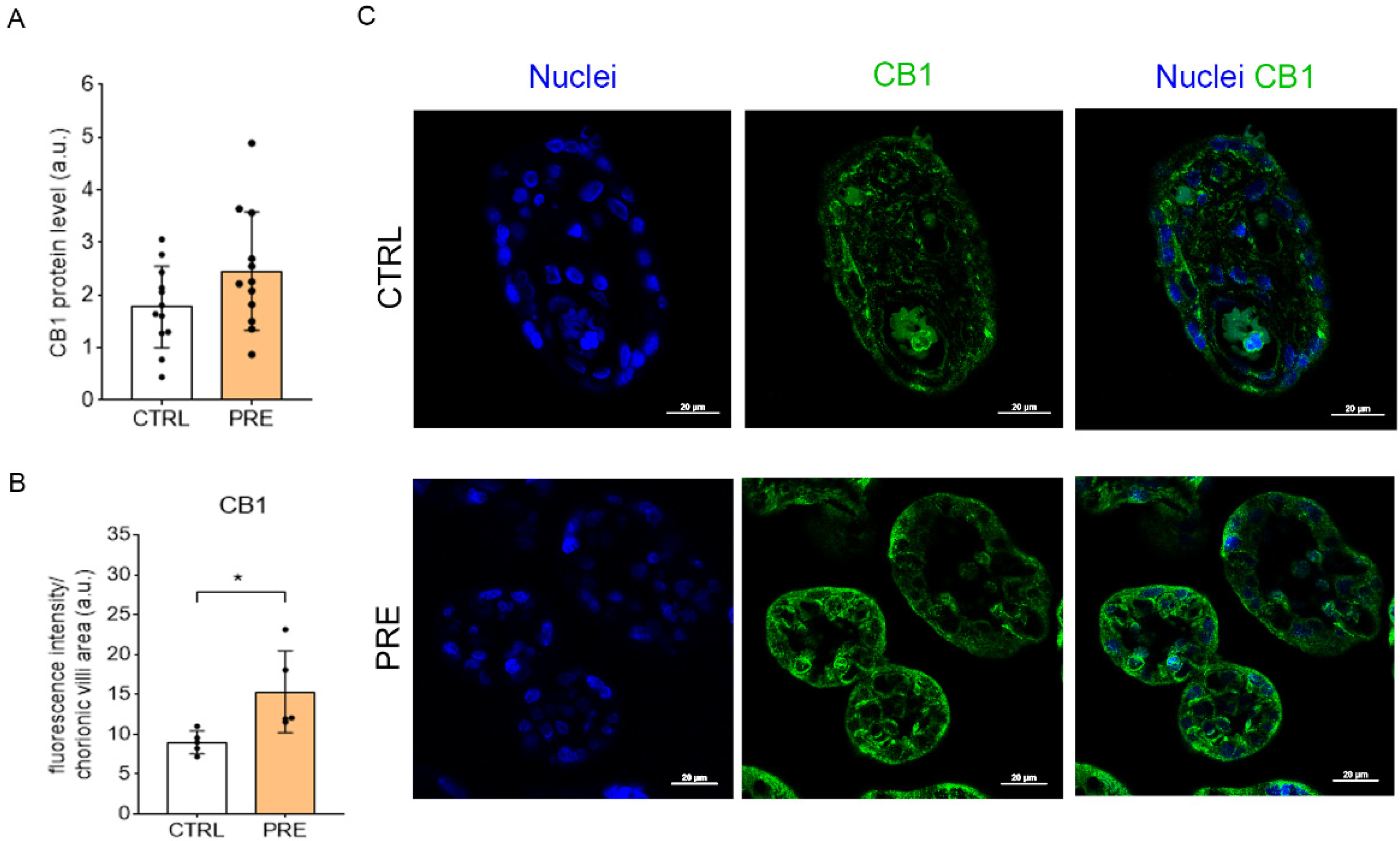
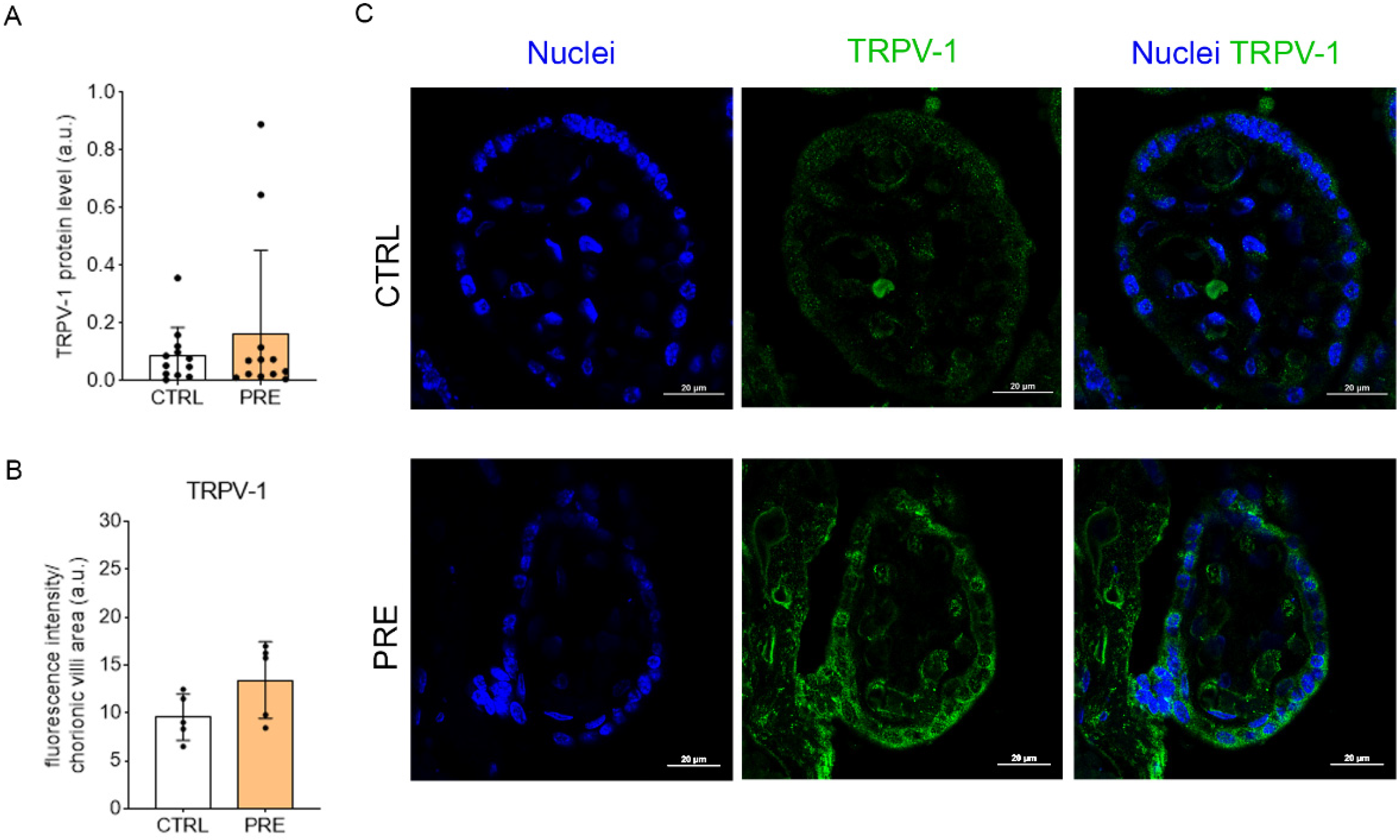
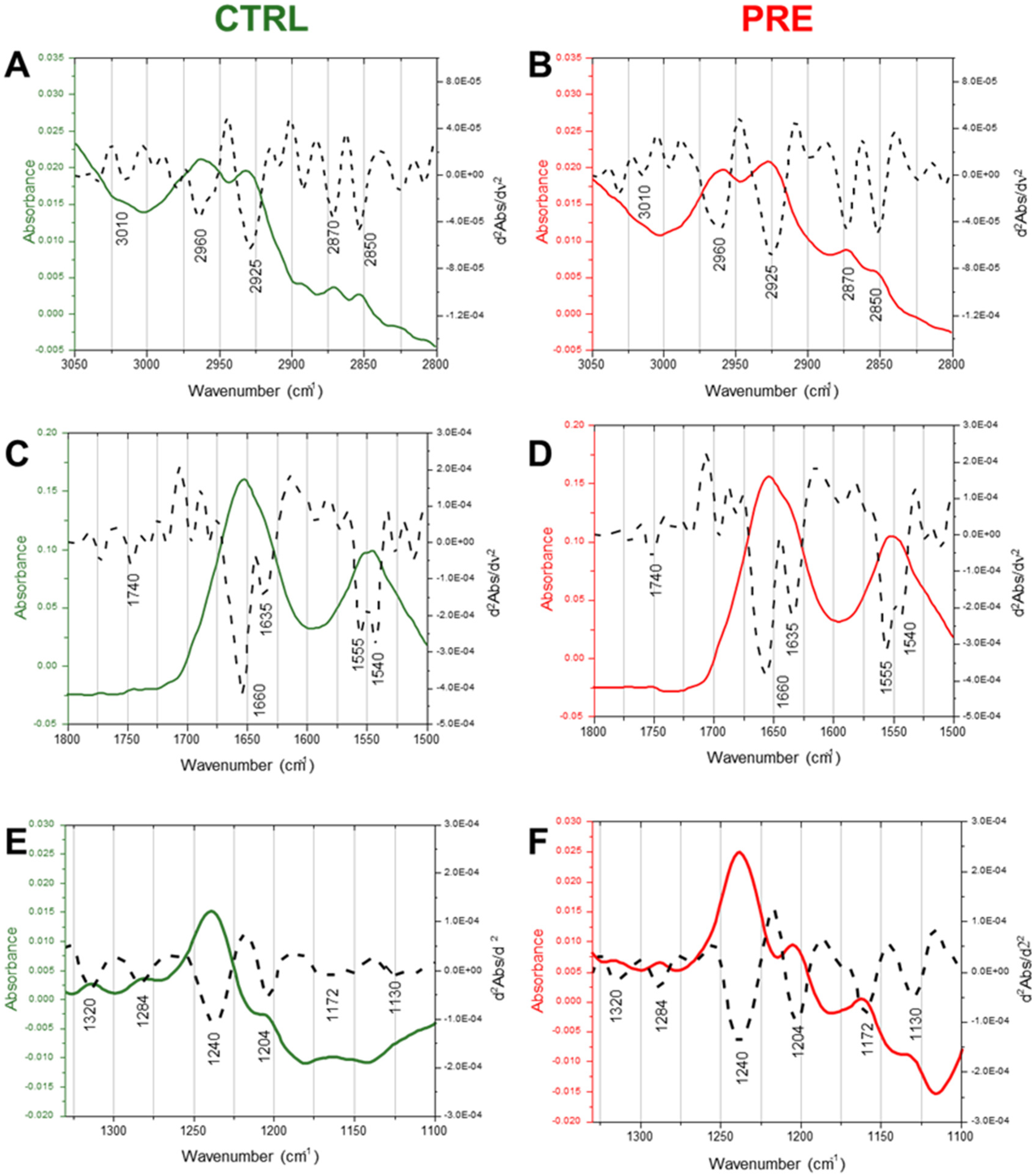

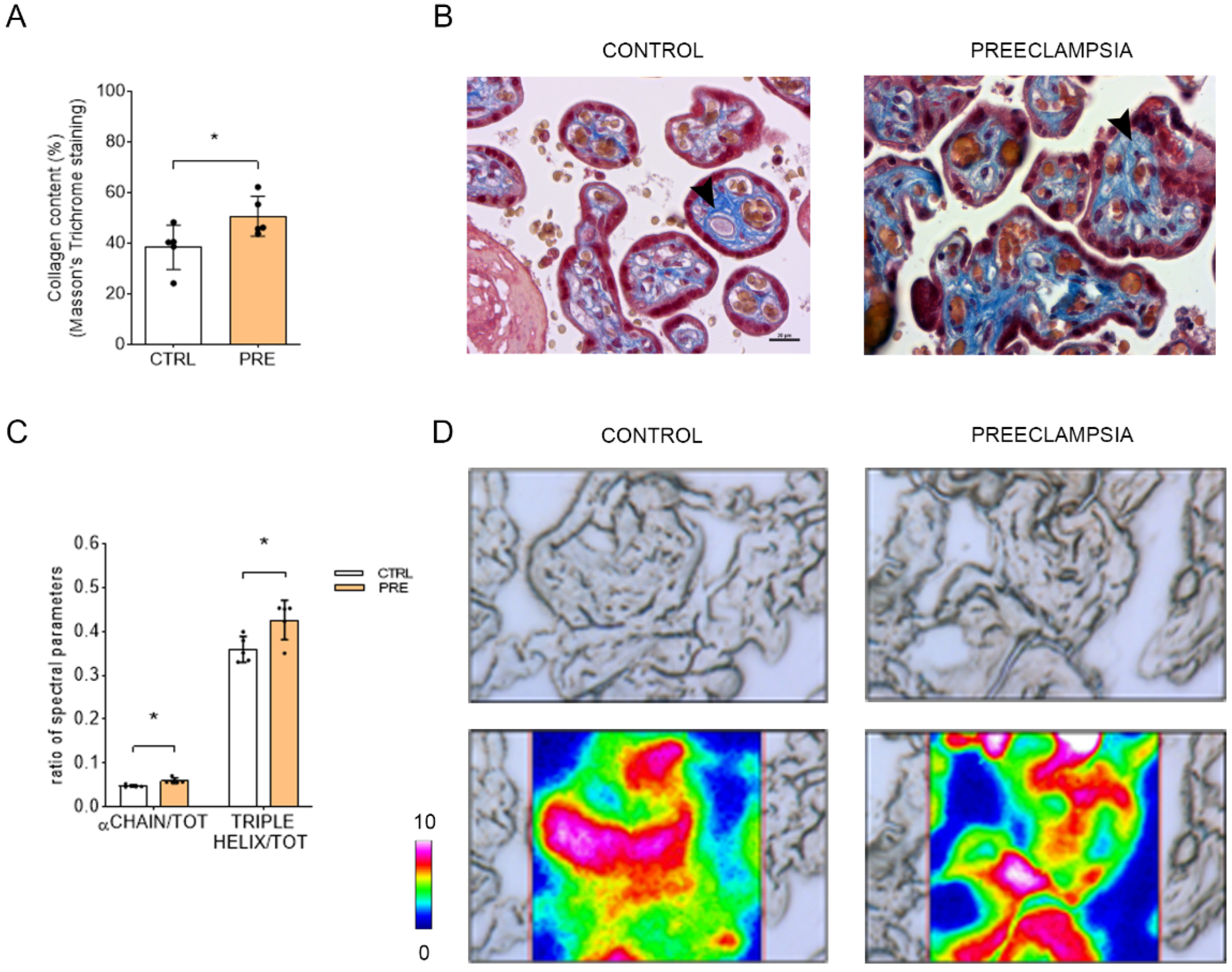
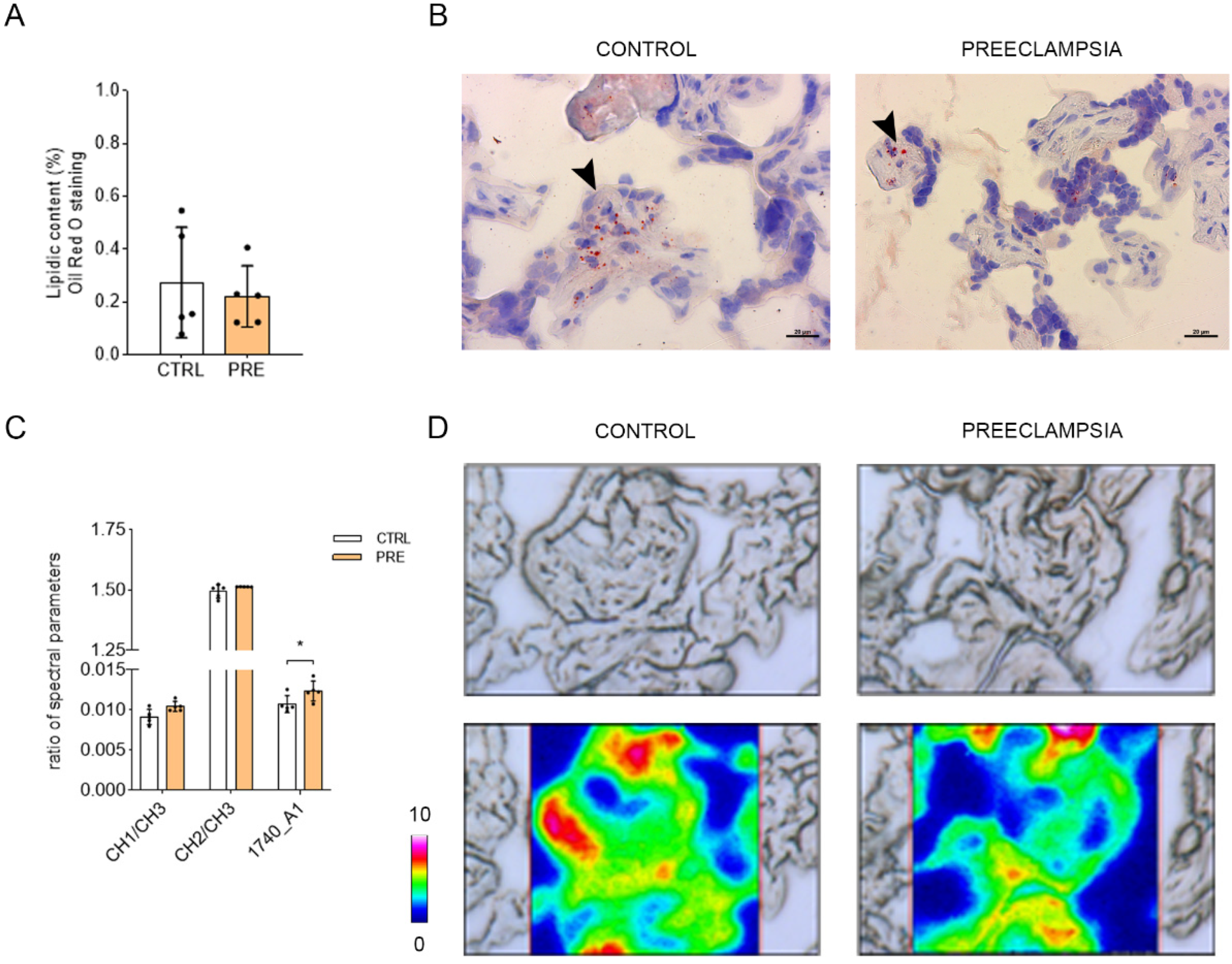
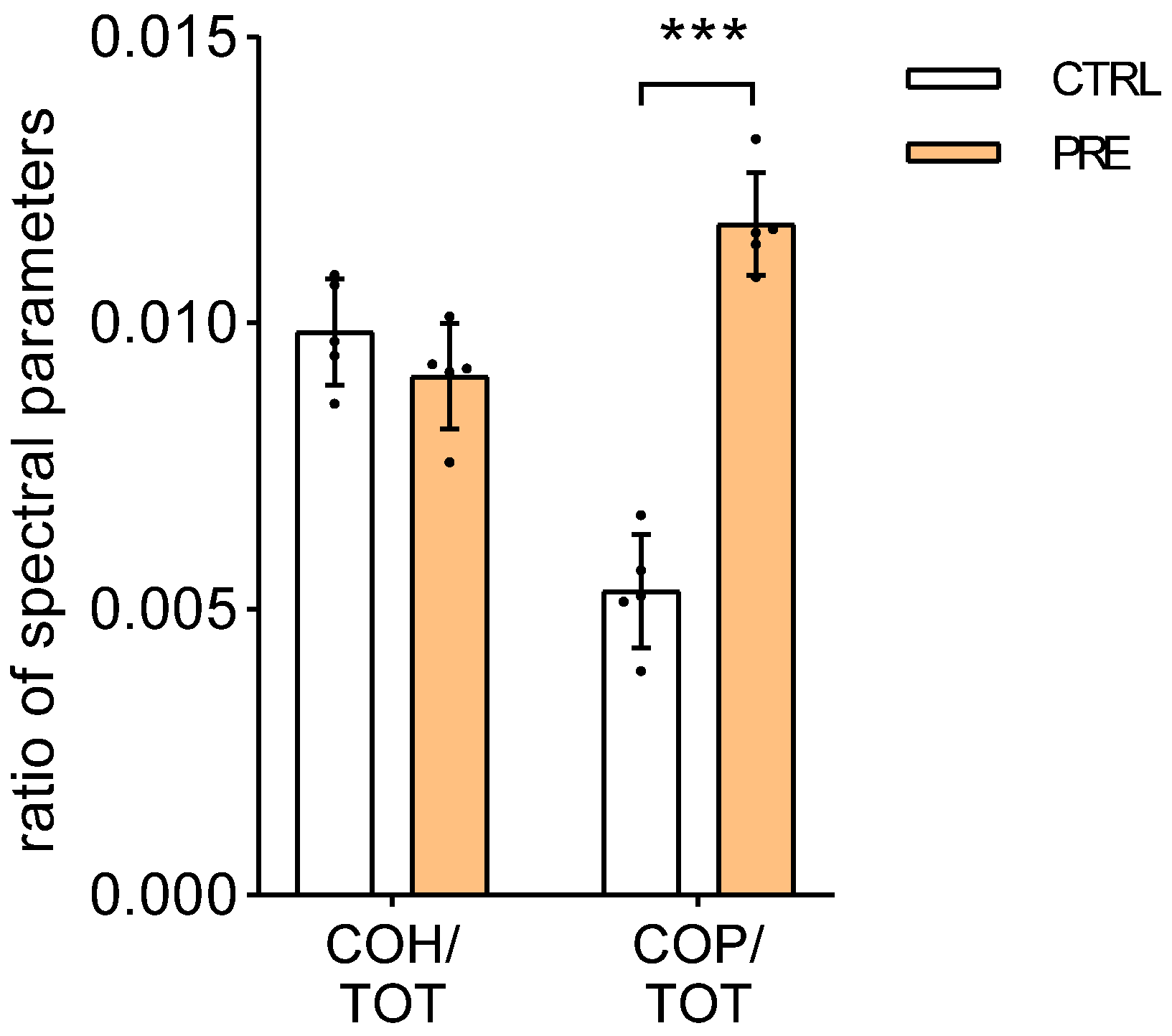
| CTRL | PRE | |
|---|---|---|
| Number of pregnant women | 12 | 12 |
| Mode of delivery (%) | ||
| Natural birth | 6 (50%) | 7 (58.3%) |
| Cesarean section | 6 (50%) | 5 (41.7%) |
| Parity | ||
| Multiparous | 9 (75%) | 7 (58.3%) |
| Primiparous | 3 (25%) | 5 (41.7%) |
| Maternal age (years) | 34.2 ± 3.1 | 37.5 ± 4.4 |
| Gestational age (weeks) | 39.4 ± 1.5 | 38.3 ± 1.4 |
| Mean blood pressure (mmHg) | ||
| Systolic | 116.7 ± 10.9 | 156.1 ± 21.06 **** |
| Diastolic | 70.9 ± 8.6 | 99.08 ± 8.7 **** |
| Signs of organ damage (%) | ||
| Proteinuria 24 h ≥ 0.3 g/dL and/or Protein/creatinine ratio ≥ 30 mg/mmol and/or dipstick 2+ | 0 (-) | 12 (100%) **** |
| AST and/or ALT > 40 U/Land/or gGT > 16 U/L | 0 (-) | 2 (15%) * |
| PLT < 150,000/mm3 | 0 (-) | 0 (-) |
| ALP > 135 U/L and/or LDH > 240 U/L | 0 (-) | 9 (75%) **** |
| Headache and/or visual symptoms | 0 (-) | 7 (58.3%) **** |
| Presence of severe neurological symptoms | 0 (-) | 0 (-) |
| Pre-pregnancy body mass index (BM) (kg/m2) | 22.5 ± 3.9 | 28.03 ± 8.5 |
| Post-pregnancy body mass index (BM) (kg/m2) | 27.2 ± 3.9 | 31.7 ± 7.9 |
| Birth weight (g) | 3410.08 ± 405.3 | 3168.3 ± 533.2 |
| Fetal sex | ||
| Female | 6 (50%) | 6 (50%) |
| Male | 6 (50%) | 6 (50%) |
Publisher’s Note: MDPI stays neutral with regard to jurisdictional claims in published maps and institutional affiliations. |
© 2022 by the authors. Licensee MDPI, Basel, Switzerland. This article is an open access article distributed under the terms and conditions of the Creative Commons Attribution (CC BY) license (https://creativecommons.org/licenses/by/4.0/).
Share and Cite
Lombó, M.; Giommi, C.; Paolucci, M.; Notarstefano, V.; Montik, N.; Delli Carpini, G.; Ciavattini, A.; Ragusa, A.; Maradonna, F.; Giorgini, E.; et al. Preeclampsia Correlates with an Increase in Cannabinoid Receptor 1 Levels Leading to Macromolecular Alterations in Chorionic Villi of Term Placenta. Int. J. Mol. Sci. 2022, 23, 12931. https://doi.org/10.3390/ijms232112931
Lombó M, Giommi C, Paolucci M, Notarstefano V, Montik N, Delli Carpini G, Ciavattini A, Ragusa A, Maradonna F, Giorgini E, et al. Preeclampsia Correlates with an Increase in Cannabinoid Receptor 1 Levels Leading to Macromolecular Alterations in Chorionic Villi of Term Placenta. International Journal of Molecular Sciences. 2022; 23(21):12931. https://doi.org/10.3390/ijms232112931
Chicago/Turabian StyleLombó, Marta, Christian Giommi, Michela Paolucci, Valentina Notarstefano, Nina Montik, Giovanni Delli Carpini, Andrea Ciavattini, Antonio Ragusa, Francesca Maradonna, Elisabetta Giorgini, and et al. 2022. "Preeclampsia Correlates with an Increase in Cannabinoid Receptor 1 Levels Leading to Macromolecular Alterations in Chorionic Villi of Term Placenta" International Journal of Molecular Sciences 23, no. 21: 12931. https://doi.org/10.3390/ijms232112931
APA StyleLombó, M., Giommi, C., Paolucci, M., Notarstefano, V., Montik, N., Delli Carpini, G., Ciavattini, A., Ragusa, A., Maradonna, F., Giorgini, E., & Carnevali, O. (2022). Preeclampsia Correlates with an Increase in Cannabinoid Receptor 1 Levels Leading to Macromolecular Alterations in Chorionic Villi of Term Placenta. International Journal of Molecular Sciences, 23(21), 12931. https://doi.org/10.3390/ijms232112931











